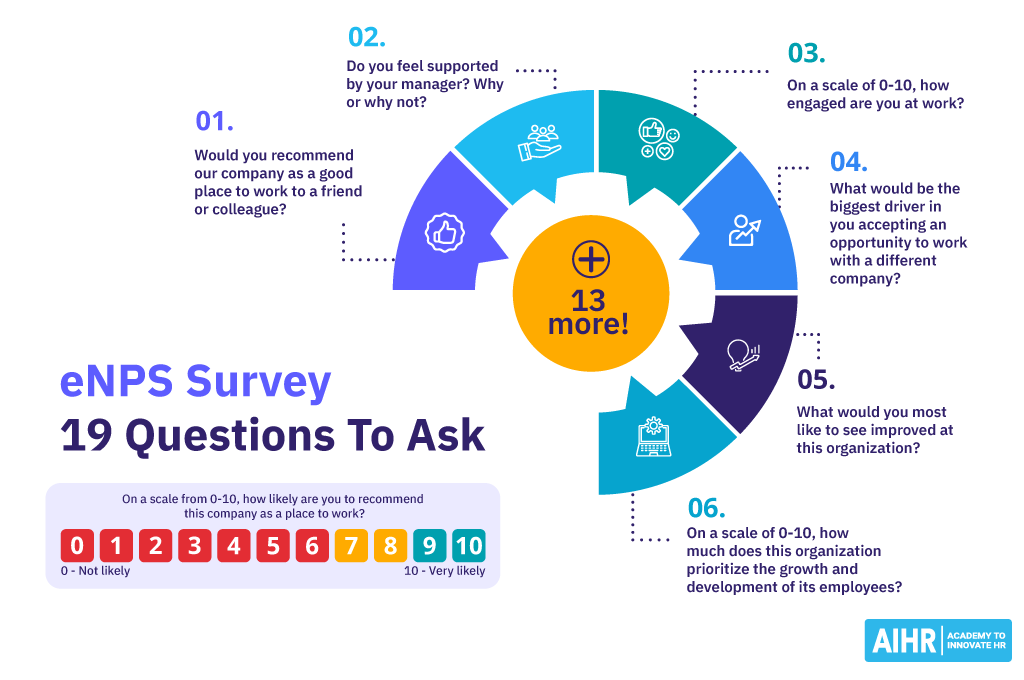19 eNPS Questions To Ask in Your Next eNPS Survey

Employee Net Promoter Score (eNPS) questions are a great way for businesses to measure how satisfied, motivated and engaged their employees are. Employee engagement has been shown to impact business performance, including absenteeism, retention, and quality of work. So, including the right eNPS questions in your survey can help you determine how engaged and loyal your employees truly are and how likely they are to be true ambassadors for the organization.
In this guide, we’ll explore what an eNPS is, types of employee net promoter score questions, and examples that you can include in your next survey.
Contents
What is an eNPS?
Types of eNPS questions to include
Employee net promoter score scale
19 employee net promoter score questions to include
FAQ
What is an eNPS?
An eNPS is a metric employers use to measure employee engagement, satisfaction, and loyalty, and how likely your employees are to recommend the organization to their personal network as a good place to work. It is based on the net promoter system created by Bain & Company in 2003, which measures customer satisfaction and loyalty and helps companies determine how likely their customers are to recommend their products or services to their friends and family.
Types of eNPS questions to include
There are different types of eNPS survey questions that you can ask employees and include in your eNPS survey. Let’s explore these below:
- Rating questions: These questions typically have an answering scale of 0-5 or 0-10 and help to gather quantitative data about your employee’s experience. For example, “On a scale of 1-10, how likely are you to recommend working at this organization to your friends and family?” Each number in the rating scale should be given an equivalent value, e.g., 0 = “not at all likely,” while 10 = “very likely.” Some rating questions avoid using numbers and will instead provide 3-5 options for the employee to select from, such as “strongly agree, agree, neither agree nor disagree, disagree, strongly disagree.”
- Open-ended questions: These questions don’t use a rating scale and allow employees to give a more detailed explanation, which provides rich and valuable qualitative data. Open-ended questions are often asked after a rating question so that a reason can be given for the previous response.
- Yes/no questions: These questions give the respondent an option of answering yes or no and typically help an employer evaluate the employee experience. For example, “Are you happy with the recent training on sales and negotiation provided to all trainee buyers?” This provides quantitative data. An open-ended question can follow this to help you understand the reasoning behind the employee’s answer.
Employee net promoter score scale
Based on the answers employees give to the eNPS survey questions, every employee has a score between 0-10, which puts them into one of three categories:
Category 1: Promotors (score of 9 or 10)
Promoters are the most loyal employees of your organization and, therefore, your brand ambassadors. They are happy, engaged, and motivated at work, keen to grow in the company and help drive the business forward.
Category 2: Passives (score of 7 or 8)
These employees are neutral. Perhaps they have neither a positive nor negative experience with their employer. While they may be happy and content in their role, they are often open to new and exciting opportunities that arise elsewhere.
Category 3: Detractors (score between 0-6)
Detractors are employees who are unhappy with their role and/or employer, often due to negative experiences at work. They tend not to have many positive things to say about their organization and are likely to express negative opinions to colleagues and within their broader personal network. Once all the responses from your survey have been collected, an employee net promoter score can be calculated.
Calculating the eNPS score
The formula for calculating eNPS is:
eNPS = % promoters – % detractors
Your eNPS score can range from -100 to 100. Scores that range from 10-30 are deemed good, those from 50-70 are seen as excellent, and anything over 80 will likely place you in the top percentages of your industry.
HR tip
Rather than getting caught up on the number of your eNPS score, strive for a consistent improvement in your eNPS score over time.
19 employee net promoter score questions to include
Asking the right questions in your employee net promoter score survey can help you uncover critical information relating to the strengths and weaknesses of your business. From here, you are in a solid position to address what’s not working and improve employee engagement, loyalty, and retention, all of which help you meet organizational goals.
Here are some eNPS example questions and the purpose behind each one.
1. On a scale of 0-10, how likely are you to recommend this organization as a good place to work to people in your personal network?
This is the primary eNPS question that typically starts off any eNPS survey. Your eNPS score is calculated based on the results of this question. The answer to this question tells you whether your employee’s experience in the workplace is positive enough that they would recommend it to their family and friends.
However, asking additional questions can be really helpful in gathering more details on the employee’s reasoning for their rating and give you valuable insight on how to do better.
2. What is the primary reason for your score?
This is a great follow-up question to your primary eNPS question. It’s an open-ended question that allows employees to freely voice what they’re happy or dissatisfied with. It gives you more insight into their most notable experiences before giving them specific prompts that target certain aspects of the employee journey.
3. What would lead you to give our organization a higher score?
If you want to know what’s most pressing to your employees in terms of improvements and making your company a great place to work, this is a suitable question. Do your employees want more support from management, better compensation and benefits, or more flexible working arrangements?
4. Would you recommend our company to a friend or colleague as a good place to work?
This is a yes/no question that can help you cement whether an employee has, on the whole, had a positive or negative experience with the company. This is especially helpful if you’re looking for quantitative data and a set of results that help you to easily evaluate the employee experience in your organization.
5. Why would you recommend or not recommend our company to a friend or colleague as a good place to work?
This is another great follow-up question from the one above. It’s an open-ended question that helps you understand the specific parts of your organization that have contributed to a positive or negative experience for your employees and in turn, affected their desire to recommend you.
6. What do you like most about working for (your company name)?
Ask this question if you want to know specifically what you’re doing well as an organization that is keeping your employees happy and motivated at work.
7. What do you like least about working for (your company name)?
To get straight to the weaker areas of the experience you’re creating for your employees (consciously or unconsciously), include this question in your next eNPS survey. Knowing what’s leaving your employees most dissatisfied or disengaged at work may be tough to hear, but this knowledge allows you to take action and improve.
8. Over the past 6 months, has your experience at our organization improved or worsened?
This is a great question if you’re constantly making improvements within the organization. It’s also a good question for organizations that have consistently had high eNPS scores and want to make sure that things are going in the right direction.
9. What is the main factor that has contributed to this change in your experience?
This is a strong follow-up question to the previous one. It’s an open-ended question that helps you gather more detail on the recent positive or negative changes in your workplace and can help you pinpoint problems and address them before they worsen.
10. Do you see yourself still working with our company in five years?
This can be a simple yes/no question with a follow-up for more information afterward, or you can add “Why or why not?” at the end and turn it into an open-ended question. If you’re looking for reasons why you’re losing your top performers or experiencing high turnover rates, ask this.
11. Do you feel supported by your manager? Why or why not?
eNPS survey questions are designed to give you a glimpse into the minds of your employees and understand why they hold the views they do. If you have a low eNPS score, and a lot of employees report they don’t feel supported by management, this is a concern, and open discussions should be had with all your leaders.
12. Do you think that our organization takes care of its employee’s health and wellbeing? Yes or no?
Do you want to know how your employees feel about the company’s approach to looking after employees’ physical, mental, and emotional health? This quantifiable question can help you see what percentage of your employees believe their wellbeing is a priority and what percentage don’t.
13. On a scale of 0-10, how engaged are you at work?
Employee engagement is directly linked to business performance, which is why knowing how engaged your employees are is critical. A good follow-up question would be to ask, “Why or why not?”
14. Why did you choose to work for this company?
This question helps you uncover common reasons why candidates are attracted to your organization and, potentially, what stands out about you against your competitors. It could be your generous compensation and benefits, your unlimited vacation policy, or the career progression you offer to all employees.
15. Has this organization met the expectations you had of your role and what working here would be like? Yes or no?
Do your job descriptions, employee testimonials, and information on your company website and social channels align with the experiences that employees have once they set foot through the door and start working for you? If many employees don’t feel they have had their expectations met, it’s a sign that you’re not being transparent enough or communicating clearly from the outset.
16. What would be the biggest driver in you accepting an opportunity to work with a different company?
This open-ended question allows employees to share what they find most attractive in a job or workplace, gives you insight into what could lead your employees to jump ship, and helps you prevent it.
17. Following the changes we made to our organization in the past 6 months, has your experience at work improved, worsened, or stayed the same?
Suppose you have made a specific change (or changes) in your workplace, for example, team restructuring, or gone in a different direction with your product or service offering. In that case, this question can help you see how this change has affected employees.
18. What would you most like to see improved at this organization?
A direct question that will help you see if there’s a common theme amongst employees regarding improvements they’d like to see in the workplace that would boost their experience and loyalty.
19. On a scale of 0-10, how much does this organization prioritize the growth and development of its employees?
Personal growth and career progression are critical factors for many employees when choosing an organization to work for, and they play a key role in how engaged and motivated they are at work.
HR tip
Select your eNPS questions based on specific challenges in your organization and what you most want to find out.
To sum up
Selecting the right eNPS questions for your next survey and regularly surveying employees will help you gauge how satisfied, motivated, and loyal your employees are to your company. Employees who demonstrate high levels of engagement and loyalty to the company will likely be ambassadors for your brand and help you attract and recruit more top talent.
When you know what’s not working in your company, you can take action and make improvements that help you boost engagement, retention, and loyalty to your organization.
FAQ
An eNPS (employee net promoter score) question is included in a survey where employees typically rate on a scale of 0-10 how likely they are to recommend the organization to their friends and family as a good place to work.
To write an effective eNPS question, consider what you most want to find out about your employee’s experience at work, whether it regards career growth, wellbeing, recognition, compensation and benefits, or something else.
Weekly update
Stay up-to-date with the latest news, trends, and resources in HR
Learn more
Related articles
Are you ready for the future of HR?
Learn modern and relevant HR skills, online













